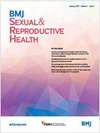依托孕酮避孕植入物(Implanon®)对哺乳期骨代谢影响的前瞻性研究
Q Medicine
Journal of Family Planning and Reproductive Health Care
Pub Date : 2016-12-01
DOI:10.1136/jfprhc-2015-101375
引用次数: 3
摘要
目的应用骨形成和骨吸收指标,评价依托孕酮避孕植入物(Implanon®)对哺乳期妇女骨代谢的影响。这项单中心、前瞻性队列研究在Turgut Ozal大学医学院妇产科进行,研究对象为年龄在24 - 38岁之间的健康哺乳期妇女,目的是比较使用植入物和非激素避孕方法6个月对骨代谢的影响。研究组(n=25)使用植入物,对照组(n=25)使用产后40天植入的非激素避孕宫内节育器。通过血清和尿液的生化分析定量评估植入时和6个月后的骨代谢差异。结果在基线时,两组血清骨代谢参数水平相似。种植体组6个月时血清碱性磷酸酶(ALP)水平降低(p=0.004),总蛋白水平升高(p=0.045)。在对照组中,6个月时骨代谢参数的血清水平与基线相比没有变化。然而,与基线相比,6个月时血清磷(p=0.013)和ALP (p=0.003)水平下降。结论产后6个月使用Implanon对健康哺乳期妇女的骨转换无不良影响。本文章由计算机程序翻译,如有差异,请以英文原文为准。
Effects of the etonogestrel contraceptive implant (Implanon®) on bone metabolism during lactation: a prospective study
Aim To evaluate the effects of the etonogestrel contraceptive implant (Implanon®) on bone metabolism in lactating women using markers for bone formation and resorption. Study design This single-centre, prospective cohort study was conducted in Turgut Ozal University Medical Faculty Obstetrics and Gynecology Department with healthy lactating women aged between 24 and 38 years to compare the effect on bone metabolism of 6 months’ use of either the implant or a non-hormonal contraceptive method. The study group (n=25) used an implant and the control group (n=25) used a non-hormonal contraceptive intrauterine device inserted 40 days’ postpartum. Bone metabolism differences at the time of insertion and after 6 months were assessed quantitatively by biochemical analysis of serum and urine samples. Results At baseline, serum levels of bone metabolism parameters were similar for the two groups. In the implant group, serum alkaline phosphatase (ALP) levels decreased (p=0.004) and total protein levels increased (p=0.045) at 6 months. In the control group, serum levels of bone metabolism parameters did not change at 6 months compared to baseline. However, serum levels of phosphorus (p=0.013) and ALP (p=0.003) decreased at 6 months compared to baseline. Conclusion Six months’ postpartum use of Implanon was found to have no deleterious impact on bone turnover in healthy lactating women.
求助全文
通过发布文献求助,成功后即可免费获取论文全文。
去求助
来源期刊

Journal of Family Planning and Reproductive Health Care
OBSTETRICS & GYNECOLOGY-
CiteScore
0.84
自引率
0.00%
发文量
0
审稿时长
>12 weeks
期刊介绍:
The trading of Professional, Managerial & Healthcare Publications Ltd has been transferred to its parent company, Keyways Publishing Ltd.
 求助内容:
求助内容: 应助结果提醒方式:
应助结果提醒方式:


